Participatory Landscape Design and Water Management—A Sustainable Strategy for Renovation of Vernacular Baths and Landscape Protection in Szeklerland, Romania
Abstract
:1. Introduction
1.1. The Landscape
1.2. The Significance of Mineral Waters from Medical and Landscape Aspects
1.3. Health and Landscape Aspects of the Bathing Culture in an International Context
2. Materials and Methods
2.1. The Rationale behind the Bath Renovation Strategy
- Community collaboration.
- Economic and ecological sustainability.
- Environmental education.
2.2. The Scenario of the Bath Renovations
2.2.1. Selection of the Location for the Bath Building Camp
- It is selected from hundreds of mineral water springs of Szeklerland at least a year before the camp, allowing enough time to prepare.
- The mineral water spring (the bath) should be located in public space that is always open to everyone.
- If a request is received from a local community, this could be a priority criterion for selection.
2.2.2. Preparation for the Camp
- Identifying team leaders. A team leader can be someone who has already participated in a camp and has the desire to work as a team leader. The team leaders decide among themselves who will take on which task with their group.
- On-site visit. The purpose of the field trip is to become acquainted with the site and its history, to make a survey (drawings of the site, photo documentation), to meet the local community and to understand their needs.
- Landscape design. Based on a concept developed collaboratively by the preparatory team and the local community, each group prepares the design on a given subject (e.g., soil erosion control, habitat protection) or object (wellhead installation, seating pool, swimming pool, changing rooms, toilets, pavilion, stairs, boardwalks etc.). This work involves landscape architects and architects or students of these disciplines (e.g., in the context of a university assignment or a student design competition). The plans will be presented to the local residents in a village forum, where they will have the opportunity to comment, discuss, and develop the idea (Figure 7, Figure 8 and Figure 9).
- Village forum. Organised by the local community. Organised by the local community, its purpose is to enable the participants of the building camp and the local residents to become to know each other and to plan together in advance.
- Cooperation agreement. Established between those coordinating and organising the camp, it includes commitments and obligations (not only for construction but also for maintenance afterwards).
- The raising of financial resources. The work of all participants is a voluntary donation. Most of the volunteers are university students. The organisers will also obtain grants to run the event (e.g., for the transport of volunteers). The local people organise the local activities (accommodation and food for the participants, purchase and transport of building materials, supply of tools, presence of local craftsmen, organisation and implementation of fundraising event in the village for the camp).
- Announcement of the camp. The building camps are organised as an open volunteer movement. The main means of recruiting participants is through university announcement, but those who have already participated spread the message among their friends. It can be considered as an internship for university students.
2.2.3. Managing the Building Camp
- Launching the camp. Some of the organisers travel to the site a few days before the start, organise the arrival, or, if the terrain is difficult and the work is heavy, carry out professional preparatory work (mowing, shrub clearance, marking out objects, etc.)
- Community work. Once the participants have arrived, the construction work starts with professional supervision. The camp is not only about building, but is also a creative event, with a rich programme of community-building and intellectual activities. (Figure 10).
- Ceremonial opening. On the last day of the camp, the renovated bath is officially opened and inaugurated by a common barbecue gathering and celebration of the participants and the entire village community.
- Afterlife of the renewed baths. Ensuring that the objective is achieved: the attachment to the place created by collaborative work also helps the local community to care for and maintain the renovated baths in the long term through their own efforts.
3. Results
3.1. Renovation of Twenty-Two Folk Baths in Szeklerland
3.2. Broad Professional and Social Participation
3.3. Landscape Architecture and Landscape Protection
3.4. Community Building
3.5. Keeping Traditions Alive
3.6. Personal Development
4. Conclusions
Author Contributions
Funding
Institutional Review Board Statement
Informed Consent Statement
Data Availability Statement
Acknowledgments
Conflicts of Interest
References
- Herczeg, Á. Fürdőépítő kalákák Székelyföldön. Zöldműves 2006, 1, 34–36. Available online: https://zoldmuves.termuves.hu/?q=furdoepito-kalakak-szekelyfoldon (accessed on 8 December 2021).
- Fekete, A. Erdélyi Tájépítészet 2000–2020—Egy Szakma Születése. I. Táj, Közösség, Műhelymunka. 12 December 2020. Available online: https://epiteszforum.hu/erdelyi-tajepiteszet-2000-2020--egy-szakma-szuletese-i-taj-kozosseg-muhelymunka (accessed on 17 December 2021).
- Fekete, A. Erdélyi Tájépítészet 2000–2020—Egy Szakma Születése. II. Oktatás, Kutatás, Tervezés. 13 December 2020. Available online: https://epiteszforum.hu/erdelyi-tajepiteszet-2000-2020--egy-szakma-szuletese-ii-oktatas-kutatas-tervezes (accessed on 17 December 2021).
- Douglas, P. Leisure Settings: Burgeois Culture, Medicine and the Spa in Modern France; University of Chicago Press: Chicago, IL, USA, 1998. [Google Scholar]
- Kósa, L. Fürdőélet a Monarchiában; Holnap Kiadó: Budapest, Hungary, 1999. [Google Scholar]
- Bender, T. A balneoterápia és a hidroterápia hatása mozgásszervi megbetegedésekben Egy régi terápia újjászületése. Lege Artis Med. 2005, 15, 921–926. [Google Scholar]
- Kox, M.; van Eijk, L.T.; Zwaag, J.; van den Wildenberg, J.; Sweep, F.C.G.J.; van der Hoeven, J.G.; Pickkers, P. Voluntary activation of the sympathetic nervous system and attenuation of the innate immune response in humans. Proc. Natl. Acad. Sci. USA 2014, 111, 7379–7384. [Google Scholar] [CrossRef] [Green Version]
- Vofkori, L. Székelyföld Útikönyve I–II; Cartographia: Budapest, Hungary, 1998. [Google Scholar]
- Székelyföld Települései, Székely Városok, Székely Falvak. Székelyföld Térképek. Available online: http://szekelyfold.terkepek.net/ (accessed on 10 December 2021).
- Juvigne, E.; Gewelt, M.; Gilot, E.; Hurtgen, C.; Seghedi, I.; Szakács, A.; Gábris, G.; Hadnagy, A.; Horváth, E. Une eruption vieille d’environ 10 700 ans (14C) dans les Carpates orientalis (Roumanie). C. R. Acad. Sci. Paris 1994, 1, 325–343. [Google Scholar]
- Moriya, I.; Okuno, M.; Nakamura, T.; Ono, K.; Seghedi, I. Radiocarbon ages of charcoal fragments from the pumice flow deposits of the last eruption of Ciomadul volcano, Romania. In Summaries of Researches Using AMS at Nagoya University (VII); Nagoya University: Nagoya, Japan, 1996; pp. 252–255. [Google Scholar]
- Kőváry, L. Erdélyfölde Ritkaságai, Kilencz fa-Metszvénynyel; Nyomtatott Kiadás: Kolozsvártt, Romania, 1853; p. 17. Available online: https://mek.oszk.hu/07800/07862/07862.pdf (accessed on 15 December 2021).
- Orbán, B. A Székelyföld Leírása, Történelmi, Régészeti, Természetrajzi s Népismei Szempontból; Nyomatott Panda és Frohna Könyvnyomdájában: Pest, Hungary, 1868; Available online: https://mek.oszk.hu/04800/04804/html/ (accessed on 17 December 2021).
- Teleki, D. A Székely Határőrség Története; Szabó Károly–Franklin: Budapest, Hungary, 1877. [Google Scholar]
- Jókai, M. Bálványosvár; Athenaeum: Budapest, Hungary, 1883. [Google Scholar]
- Hankó, V. Székelyföld; Lampel Róbert (Wodianer, F. és Fiai): Budapest, Hungary, 1896; Available online: https://mek.oszk.hu/10700/10784/10784.pdf (accessed on 8 December 2021).
- Bányai, J. Adatok a Hargitai Ásványvizek Geológiájához. Emlékkönyv a Székely Nemzeti Múzeum 50 Éves jubileumára; Székely Nemzeti Múzeum: Sepsiszentgyörgy, Romania, 1929. [Google Scholar]
- Móricz, Z. Erdély. Tündérkert; Athaeneum Kiadó: Budapest, Hungary, 1939. [Google Scholar]
- Bierbauer, V. A Székelyföld templomairól. Magyarságtudomány 1942, 1, 144–145. [Google Scholar]
- Kónya, Á.; Kovács, S. Bálványosfürdő és Környéke; Kovászna Megyei Turisztikai Hivatal: Sepsiszentgyörgy, Romania, 1970. [Google Scholar]
- Szádeczky, L. A Székely Nemzet Története és Alkotmánya; Csíkszereda Kiadóhivatal: Csíkszereda, Romania, 2017. [Google Scholar]
- Schmidl, A. Reisehandbuch Durch das Königriech Ungarn Mit den Nebenländern und Dalmatien, Nach Serbien, Bukarest und Constantinopel; Gerold: Wien, Austria, 1835. [Google Scholar]
- Paget, J. Ungarn und Siebenbürgen: Politisch, Statistisch, Öconomisch; Verlag von J. J. Weber: Leipzig, Germany, 1842; Volume 2. [Google Scholar]
- De Gerando, A. La Transylvanie et Ses Habitants; Imprimeurs-Unis: Paris, France, 1845. [Google Scholar]
- Fermor, P.L. Between the Woods and the Water: On Foot to Constantinople: From the Middle Danube to the Iron Gates; John Murray Press: London, UK, 2004. [Google Scholar]
- ELC. Council of Europe Landscape Convention, European Treaty Series—No. 176. 2000. Available online: https://www.coe.int/en/web/landscape/text-of-the-european-landscape-convention (accessed on 7 December 2021).
- Ambrus, T. A Székely Falutízesek, Egy Sajátos Településrendszer, Mint a Társadalmi-Gazdasági Tevékenység Kerete. Ph.D. Thesis, Faculty of Sciences, Doctoral School of Earth Sciences, University of Pécs, Pécs, Hungary, 2010; p. 24. Available online: http://old.foldrajz.ttk.pte.hu/phd/phdkoord/nv/disszert/disszertacio_ambrus_nv.pdf (accessed on 8 December 2021).
- Egyed, Á. A Székelyek Rövid Története a Megtelepedéstől 1989-ig; Pallas-Akadémia: Budapest, Hungary, 2013. [Google Scholar]
- Imreh, I. A Rendtartó Székely Falu; Kriterion Könyvkiadó: Bukarest, Hungary, 1973; p. 294. [Google Scholar]
- Rackam, O. The History of the Countryside—The Classic History of Britain’s Landscape, Flora and Fauna; Orion Publishing Corp.: London, UK, 1986. [Google Scholar]
- Muir, R. Landscape Encyclopedia—A Reference Guide to the Historic Landscape; Windgather: Bollington, UK, 2004. [Google Scholar]
- Ambrus, T. A gyepű mint kultúrtájtípus Székelyföldön. Tájökológiai Lapok 2009, 7, 65–79. [Google Scholar]
- Eplényi, A.; Erwin, F. Lynchets—Ackerterrassenlandschaften in Rumänien—Die landschaftsprägenden Ackerterrassen in Kalotaszeg. Zoll+ Osterr. Schr. Landscahft Freiraum 2011, 21, 62–66. [Google Scholar]
- Csemez, A. Tájtervezés-Tájrendezés; Mezőgazda Kiadó: Budapest, Hungary, 1997; pp. 193–195. [Google Scholar]
- Swanwick, C. Landscape Character Assessment—Guideance for England and Scotland; The Countryside Agency & Scottish National Heritage; Cheltenham, Gloucestershire and Scottish Natural Heritage; Countryside Agency: Edinburgh, UK, 2002. [Google Scholar]
- Wöbse, H.H. Landschaftsästhetik—Über das Wesen, die Bedeutung und den Umgang mit landschaftlicher Schönheit, 1st ed.; Verlag Eugen Ulmer: Stuttgart, Germany, 2002. [Google Scholar]
- Rippon, S. Historic Landscape Analysis—Deciphering the Countryside; Council for British Archaeology: York, UK, 2004. [Google Scholar]
- Dragoman, D.; Luca, S.-A.; Gheorghiță, B. Szeklerland and The Birth of a New Region in Europe: An Inquiry into Symbolic Nationalism. Studia Politica Rom. Political Sci. Rev. 2020, 20, 33–54. Available online: https://nbn-resolving.org/urn:nbn:de:0168-ssoar-68464-1 (accessed on 13 December 2021).
- Newall, V. The Destruction of the Hungarian Villages in Romania. Anthropol. Today 1988, 4, 3–5. [Google Scholar] [CrossRef]
- Barbócz, Z. The Branding Power of Szeklerland. Online Place Branding Tendencies and Identity-Forming Efforts in Szeklerland. Acta Univ. Sapientiae Commun. 2020, 7, 143–156. [Google Scholar] [CrossRef]
- Jakab, A.-Z.; Vajda, A. (Eds.) The New Contexts of Cultural Heritage: Function, Usage, Interpretation; Kriza János Néprajzi Társaság: Cluj-Napoca, Romania, 2020. [Google Scholar]
- Jánosi, C.; Péter, É. (Eds.) A Hargita-Hegység és Környéke Ásványvizes Fürdői; CSTTE: Csíkszereda, Romania, 2003. [Google Scholar]
- Jánosi, C.; Berszán, J.; Péter, É. A Csomád-hegység ásványvizes fürdői (Mineral spas of Csomád/Ciomatu Massif). Acta Siculica (Természettudományok) 2011, 1, 41–56. [Google Scholar]
- DIRECTIVA 2009/54/CE A PARLAMENTULUI EUROPEAN ȘI A CONSILIULUI din 18 Iunie 2009 Privind Exploatarea și Comercializarea Apelor Minerale Naturale. Jurnalul Oficial al Uniunii Europene. 2009. Available online: Efaidnbmnnnibpcajpcglclefindmkaj/viewer.html?pdfurl=https%3A%2F%2Fwww.apeleminerale.ro%2F_res%2Fpdf%2F1C.pdf&clen=850511&chunk=true (accessed on 12 December 2021).
- Zsigmond, E. (Ed.) Székelyföld Borvizei és Gyógyfürdői; Cartographia: Budapest, Hungary, 2017. [Google Scholar]
- Czellecz, B. Ásványvizekben bővelkedő Székelyföld. Művelődés 2014, LXVII, 10. Available online: https://muvelodes.net/tudomany/asvanyvizekben-bovelkedo-szekelyfold (accessed on 19 December 2021).
- Mátyus, I. Diaetetica; Páldi István: Kolozsváratt, Romania, 1762; pp. 374–375. Available online: https://library.hungaricana.hu/hu/view/ORSZ_ORVO_Muzealis_35_1_Matyus_Diaetetica_az_az_a_jo_eletnek_1/?pg=0&layout=s (accessed on 14 December 2021).
- Crantz, H.J. Gesundbrunnen der Oesterreichischen Monarchie; Gedruckt bey Joseph Gerold: Wien, Austria, 1777. [Google Scholar]
- Herczeg, Á.; Jánosi, C. A Csomád-bálványosi gyógyfürdőzés, turizmus és vendégvárás történetéből. Országépítő 2002, 13, 39–41. [Google Scholar]
- Jánosi, C.; Péter, É.; Herczeg, Á. (Eds.) Székelyföldi Fürdők, Gyógyhelyek; B. K. L. Kiadó: Szombathely, Hungary, 2005. [Google Scholar]
- Mirk, L. A székelyföldi borvízforrások vizeinek és neveinek sokfélesége. Honismeret 2009, 37, 96–100. Available online: https://epa.oszk.hu/03000/03018/00214/pdf/EPA03018_honismeret_2009_05_096-100.pdf (accessed on 13 December 2021).
- Kis, B.-M.; Baciu, C. The mineral waters from the Eastern Carpathians: A historical and chemical overview. EcoTerra-J. Environ. Res. Prot. 2013, 36, 9–16. [Google Scholar]
- Cseh, K. Borszék Gyógyászati és Nemzetgazdasági Szempontból; Pesti Könyvnyomda RT: Pest, Hungary, 1873. [Google Scholar]
- Knöpfler, W. Geognostisch-balneologische Skitzen aus Siebenbürgen. In Verhandlungen und Mittheilungen des Siebenbürgischen Vereins für Naturwissenschaften zu Hermannstadt; Jahrgang VII. N-ro 1 Janner; Siebenbürgischer Verein für Naturwissenschaften zu Hermannstadt: Hermannstadt, Romania, 1856; pp. 213–219. [Google Scholar]
- Orbán, B. A székelyek Származásáról és Intézményeiről; Arcanum Digitális Tudománytárban: Kolozsvár, Romania, 1888; Available online: www.arcanum.com/hu/online-kiadvanyok/Lexikonok-magyar-irok-elete-es-munkai-szinnyei-jozsef-7891B/o-9DACB/orban-balazs-lengyelfalvi-baro-9E0CC/ (accessed on 13 December 2021).
- Vofkori, G. Székelyudvarhely-Várostörténet Képekben; Polis Kiadó: Kolozsvár, Romania, 2011. [Google Scholar]
- Kőváry, L. A Lajtántúli Fürdők Szervezete És Berendezése, Tekintettel az Erdélyi Fürdők Kívánalmaira; Ajtai K. Albert Könyvnyomdája: Kolozsvár, Romania, 1891. [Google Scholar]
- Zepeczaner, J. Fürdők a Hargita nyugati oldalán a dualizmus korában. Korunk 2009, 3, 36–45. [Google Scholar]
- Kósa, L. Fürdőkultúra és természetszemlélet kapcsolata a felvilágosodástól a 20. század elejéig. In Európa híres kertje: Történeti Ökológiai Tanulmányok Magyarországról; R.-Várkonyi, Á., Kósa, L., Eds.; Orpheusz: Budapest, Hungary, 1993; pp. 201–222. [Google Scholar]
- Blackbourn, D. Fashionable Spa Towns in Nighteenth-century Europe. In Water, Leisure and Culture: European Historical Perspectives; Anderson, S.C., Tabb, B.H., Eds.; Berg Publishers: Oxford, UK; New York, NY, USA, 2002; pp. 9–22. [Google Scholar]
- Pearalta, M.A. Heilende Wasser in Ungarn; Carita Bt: Budapest, Hungary, 2004. [Google Scholar]
- Böröcz, J. Leisure Migration—A Sociological Study on Tourism; Elsevier: Oxford, UK, 1996. [Google Scholar]
- Gidó, C. Magyar Karlsbad. Székely Fürdők az Osztrák Monarchia Korában. 2011. Available online: https://eletmod.transindex.ro/?cikk=14348 (accessed on 4 January 2022).
- Lövei-Kalmár, K. A fürdőélet átalakulása Magyarországon a 20. században a társadalmi, politikai változások tükrében. In Vörös és Fehér: Társadalmi-Politikai Átmenetek Északkelet-Magyarországon a 19–20. Század Fordulójától; Eszterházy Károly Egyetem Líceum Kiadó: Eger, Hungary, 2020; pp. 177–192. [Google Scholar]
- Kurek, K.A.; Heijman, W.; van Ophem, J.; Gedek, S.; Strojny, J. Geothermal spas as a local development factor, the case of Poland. Geothermics 2020, 85, 1–8. [Google Scholar] [CrossRef]
- McGrath, E.; Harmer, N.; Yarwood, R. Ferries as travelling landscapes: Tourism and watery mobilities. Int. J. Cult. Tour. Hosp. Res. 2020, 14, 321–334. [Google Scholar] [CrossRef]
- Nistoreanu, P.; Aluculesei, A.-C. Can Spa Tourism Enhance Water Resources and Turn Them into a National Brand? A Theoretical Review about the Romanian Case. Information 2021, 12, 270. [Google Scholar] [CrossRef]
- Vodenska, M. (Ed.) Hospitality and Toursim in Transition in Central and Eastern Europe: A Comparative Analyzis; Cambridge Scholar Publishing: Newcastle upon Tyne, UK, 2018. [Google Scholar]
- Wood, K. Health and Hazard: Spa Culture and the Social History of Medicine in the Nineteenth Century; Cambridge Scholars Publishing: Newcastle upon Tyne, UK, 2013; ISBN 978-1-4438-4099-6. [Google Scholar]
- Aluculesei, A.-C.; Nistoreanu, P.; Avram, D.; Nistoreanu, B.G. Past and Future Trends in Medical Spas: A Co-Word Analysis. Sustainability 2021, 13, 9646. [Google Scholar] [CrossRef]
- COE. Cultural Route of the Council of Europe. 2010. Available online: https://www.coe.int/en/web/cultural-routes/european-route-of-historic-thermal-towns (accessed on 12 December 2021).
- Crook, J.K. The Mineral. Waters of the United States and Their Therapeutic Uses; Leo Bros: New York, NY, USA, 1899. [Google Scholar]
- Choukroun, M.L.; Varene, P. Adjustments in oxygen transport during head-out immersion in water at different temperatures. J. Appl. Physiol. 1990, 68, 1305–1315. [Google Scholar] [CrossRef] [PubMed]
- Hembry, P.M. The English Spa, 1560–1815: A Social History; The Athlone Press: London, UK, 1990. [Google Scholar]
- Benedetto, A.V.; Millikan, L.E. World survey of mineral water and spas Mineral Water and Spas in the United States. Clin. Dermatol. 1996, 14, 583–600. [Google Scholar] [CrossRef]
- Srámek, P.; Simecková, M.; Jánsky, L.; Savliková, J.; Vybíral, S. Human physiological responses to immersion into water of different temperatures. Eur. J. Appl. Physiol. 2000, 81, 436–442. [Google Scholar] [CrossRef] [PubMed]
- Huttunen, P.; Kokko, L.; Ylijukuri, V. Winter swimming improves general well-being. Int. J. Circumpolar Health 2004, 63, 140–144. [Google Scholar] [CrossRef] [PubMed]
- Sato, D.; Kaneda, K.; Wakbayashi, H.; Nomura, T. The water exercises improve health-related quality of life of frail elderly people at day service facility. Qual. Life Res. 2007, 16, 1577–1585. [Google Scholar] [CrossRef]
- Bleakley, C.; Mcdonough, S.; Gardner, E.; Davison, G.W.; Naxter, D.G.; Hopkins, J.T. Cold-water immersion (cryotherapy) for preventing and treating muscle soreness after exercise. Pub. Med. Gov. 2012, 2, 38–56. [Google Scholar] [CrossRef] [Green Version]
- Mooventhan, A.; Nivethitha, L. Scientific Evidence-Based Effects of Hydrotherapy on Various Systems of the Body. N. Am. J. Med. Sci. 2014, 6, 199–209. [Google Scholar] [CrossRef] [Green Version]
- Huang, S.-J.; Tang, P.-X. Study on Su-Ao Cold Springs Park Service Quality Attributes Using a Kano Model. Leis. Ind. Res. 2009, 7, 4558–4567. [Google Scholar] [CrossRef]
- Battisti, C.; Cerfolli, F. From Citizen Science to Citizen Management: Suggestions for a pervasive fine-grained and operational approach to biodiversity conservation. Isr. J. Ecol. Evol. 2021, 1, 1–5. [Google Scholar] [CrossRef]
- AT 2002. Available online: https://www.arstopia.hu (accessed on 6 December 2021).
- Rudofsky, B. Architecture without Architects, an Introduction to Nonpedigreed Architecture, Nov 11, 1964–Feb 7, 1965; The Museum of Modern Art (MoMA); Doubleday: New York, NY, USA, 1964. [Google Scholar]
- Lepik, A. Small Scale, Big Change: New Architectures of Social Engagement, Oct 3, 2010–Jan 3, 2011; Exhibition; The Museum of Modern Art (MoMA): New York, NY, USA, 2010. [Google Scholar]
- Epstein-Marvis, M. The Rise and Rise of Pop-Up Architecture, How Temporary Design Became Mainstream. Curbed. 9 March 2016. Available online: https://archive.curbed.com/2016/3/9/11180920/architecture-history-temporary-banksy (accessed on 19 December 2021).
- Karim, F. (Ed.) The Routledge Companion to Architecture and Social Engagement; Routledge: London, UK, 2020; ISBN 9780367580674. [Google Scholar]
- Jakab, C. ÉP-ÍT-ÉS: A Kárpát-Medencei Modell—A Magyarországi Építész-Alkotótáborok Története; MMA Kiadó: Budapest, Hungary, 2017. [Google Scholar]
- Jacobson, S.K.; McDuff, M.D.; Monroe, M.C. Conservation Education and Outreach Techniques; Oxford University Press: Oxford, UK, 2015. [Google Scholar]
- Jakab, C.; Márton, L.A. Building, 14. Nemzetközi Építészeti Biennále—La Biennale di Venezia; M. Alkotóművészeti Közhasznú Nonprofit Kft.: Szentendre, Hungary, 2014. [Google Scholar]
- Herczeg, Á. A tájfejlődés lehetőségei, Dörögdi-medence. Országépítő 1993, 4, 36–38. [Google Scholar]
- Herczeg, Á. Tájban élünk. Ökotáj 2004, 33–34, 93–100. [Google Scholar]
- Herczeg, Á.V. Székelyföldi fürdőépítő kaláka. Országépítő 2005, 3, 28–34. [Google Scholar]
- Herczeg, Á.; Tikk, D.; Rahnama, A. Torsanlorenzo-díjas a Székelyföldi Fürdő- és Közösségépítő Kaláka mozgalom. Országépítő 2011, 22, 12–15. [Google Scholar]
- Herczeg, Á. (Ed.) Kalákázni jó! Ars Topia Alapítvány: Budapest, Hungary, 2017. [Google Scholar]
- Turi, A. A “Tájgyógyító”. MMA 2019. Available online: https://www.mma.hu/hr/ (accessed on 17 December 2021).
- Sárospataki, M. A sepsibükszádi Mikes-fürdők tájépítészeti rehabilitációja, In A táj változásai a Kárpát-medencében. Az erdélyi táj változásai; Füleky, G., Ed.; Környezetkímélő Agrokémiáért Alapítvány-SZIE: Gödöllő, Hungary, 2008; pp. 138–143. [Google Scholar]
- Herczeg, Á.; Jánosi, C.; Jánosi, K. Székelyföldi Fürdők, Gyógyhelyek. BKL Kiadó: Budapest, Hungary, 2005. [Google Scholar]
- Huszka, J. A Székely Ház; Pesti Könyvnyomda-Részvény-Társaság: Budapest, Hungary, 1895. [Google Scholar]
- Huszka, J. A Magyar Turáni Ornamentika Története; Pátria: Budapest, Hungary, 1930. [Google Scholar]
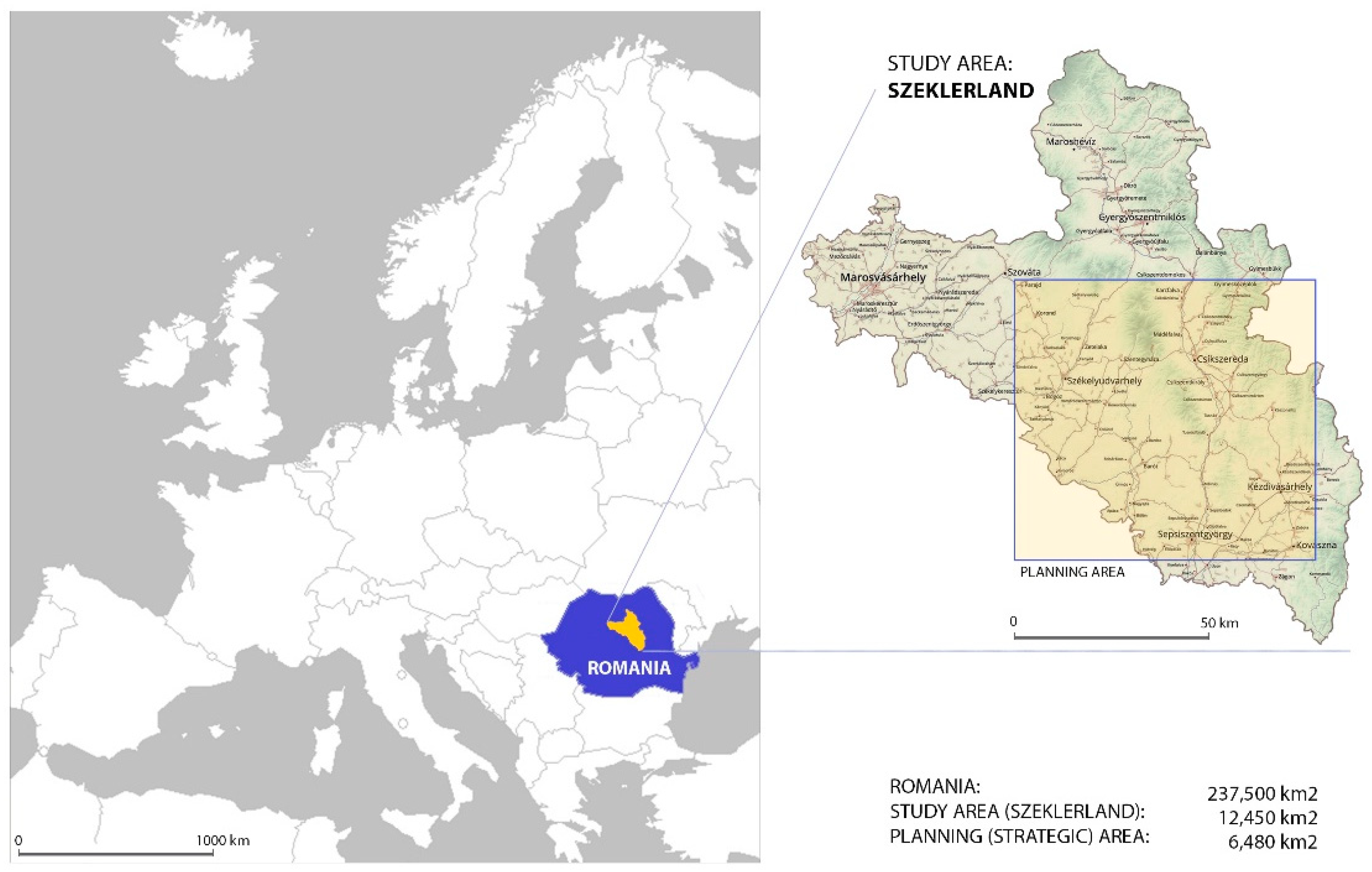
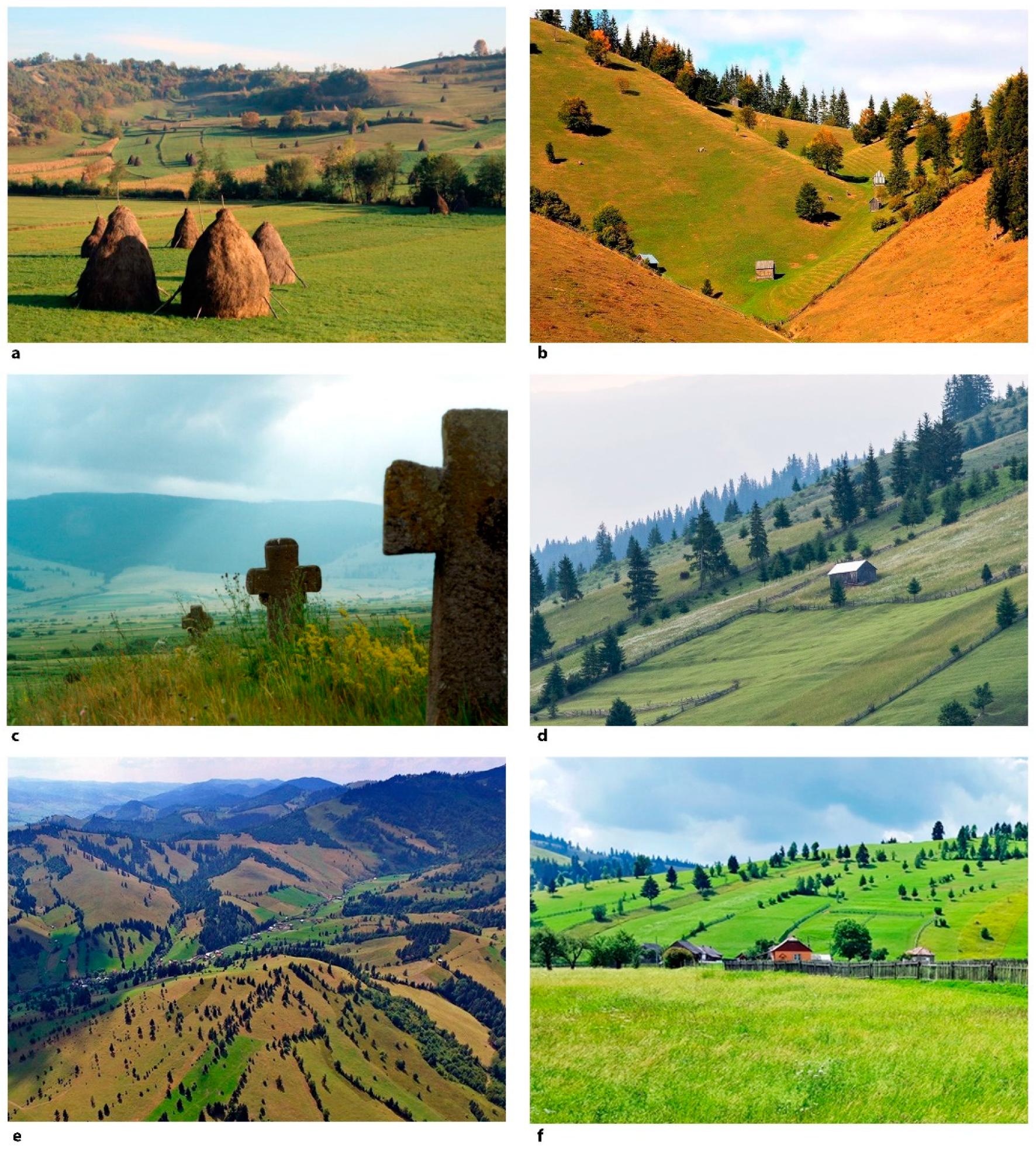

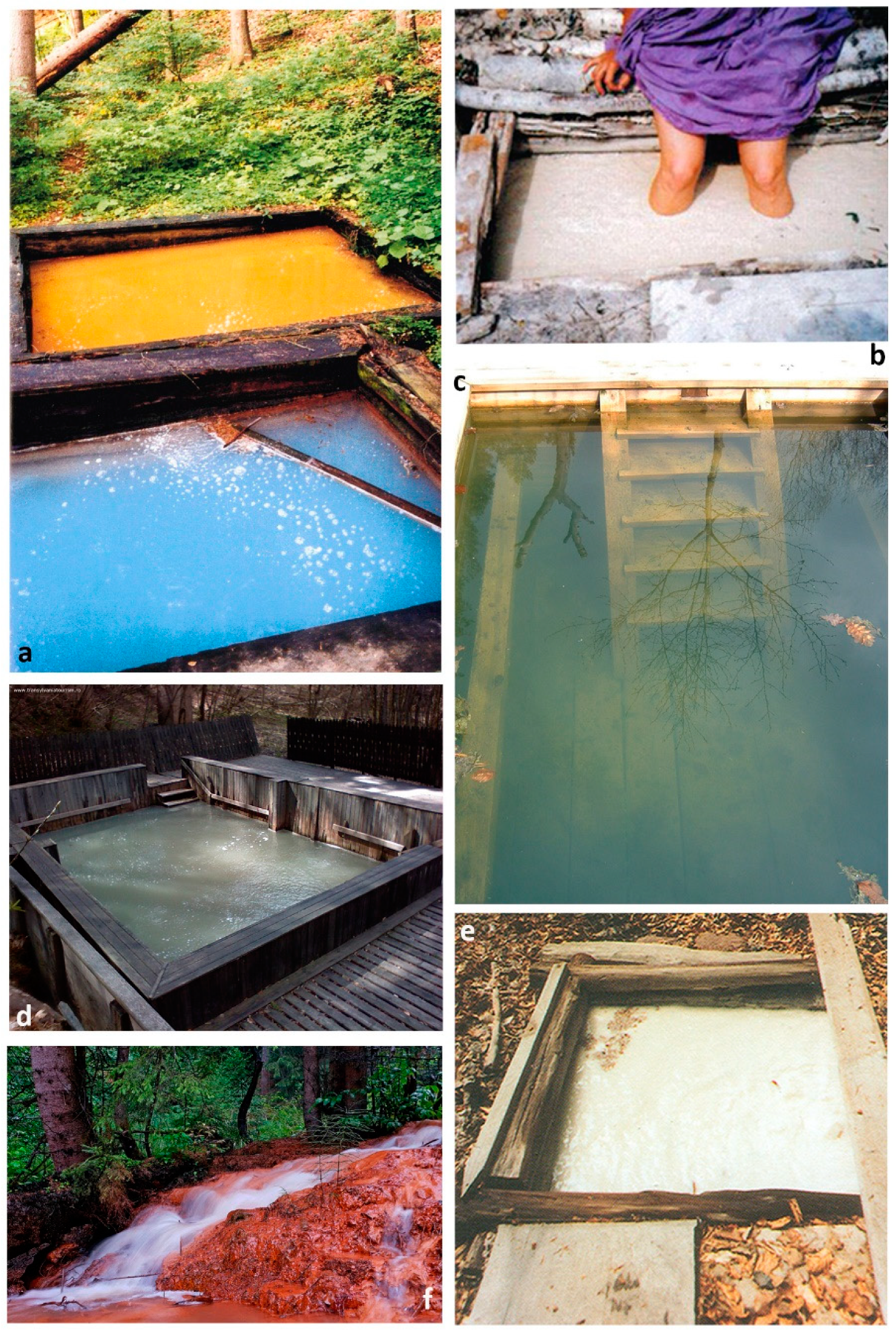

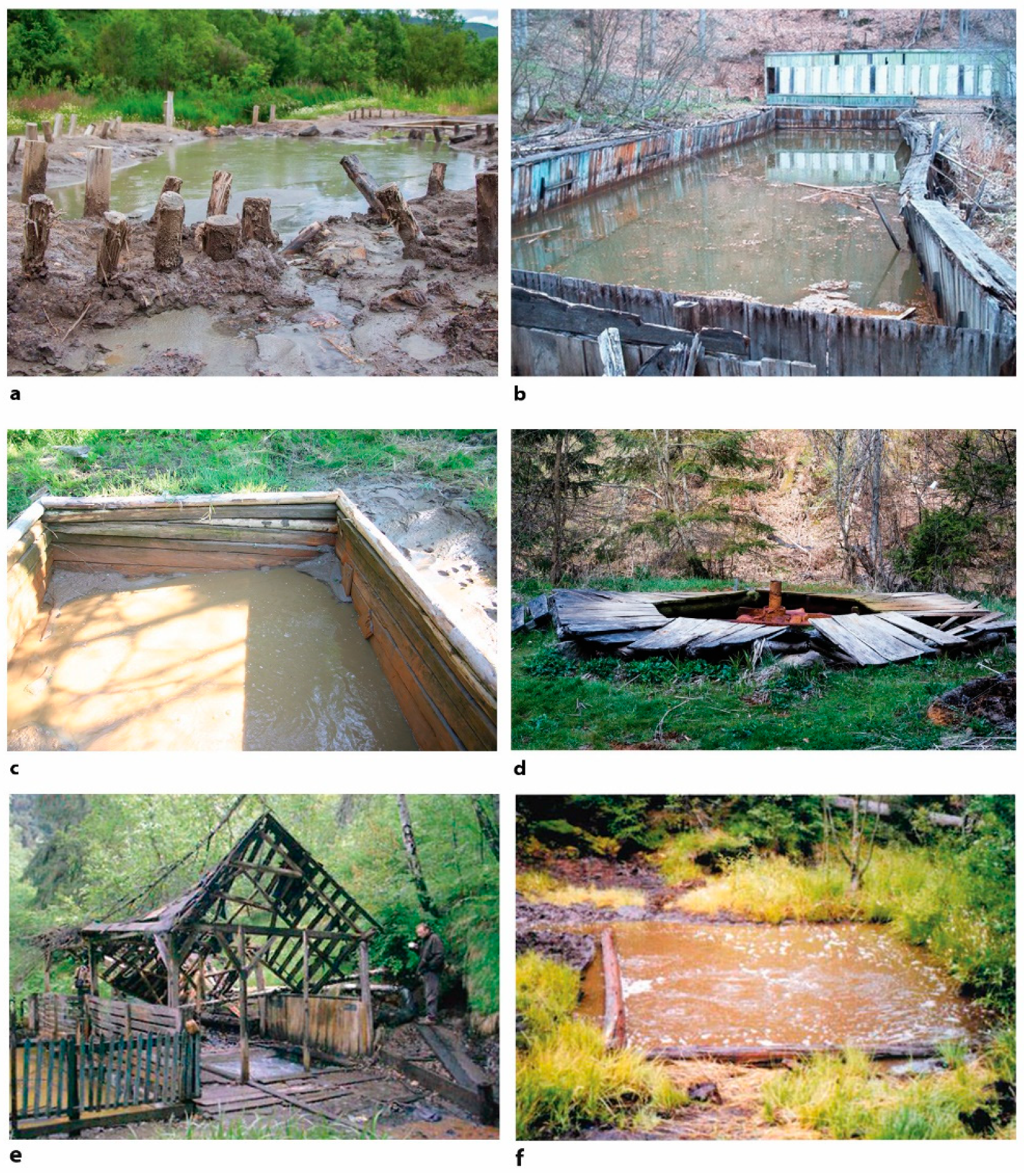
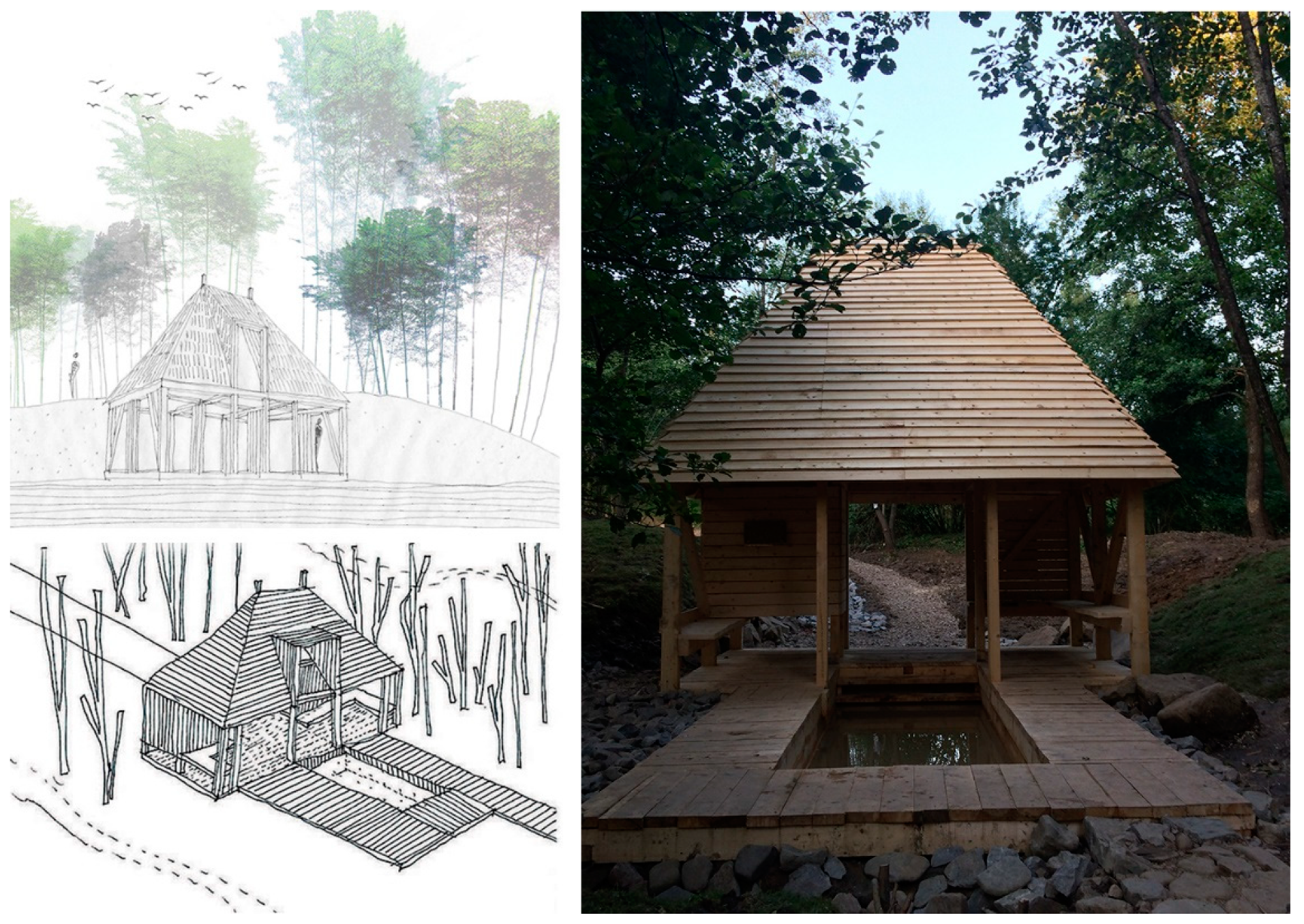
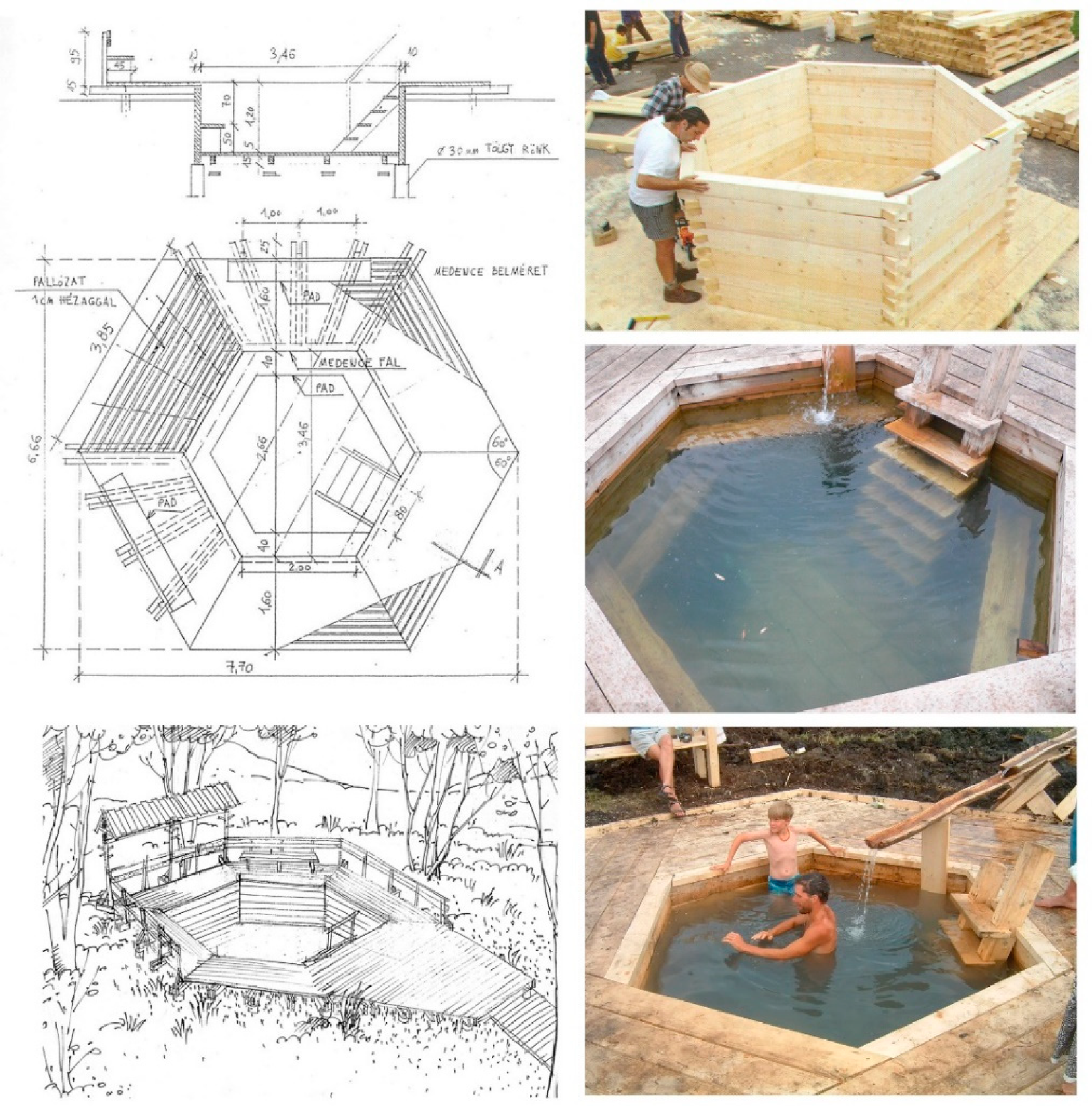
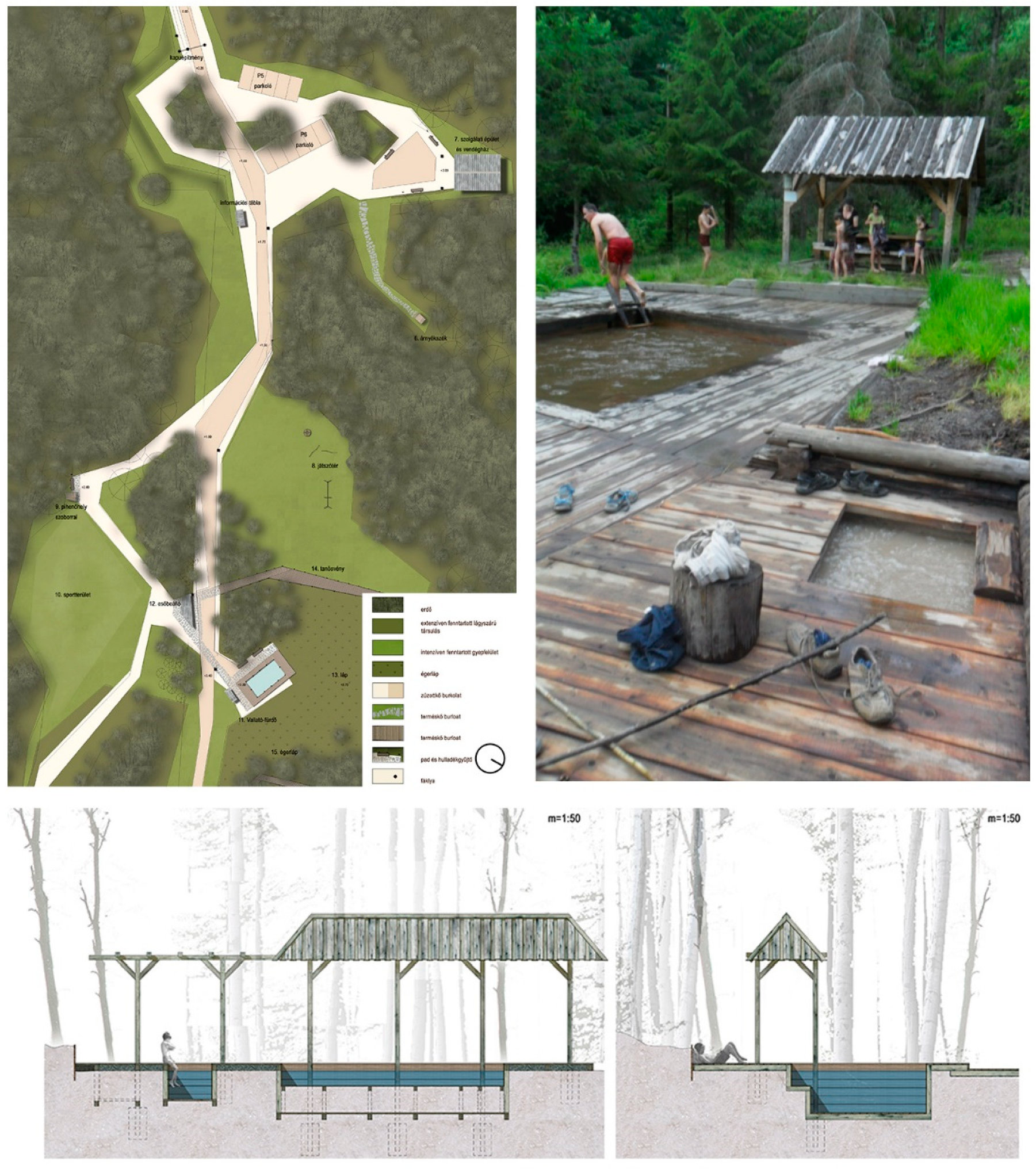
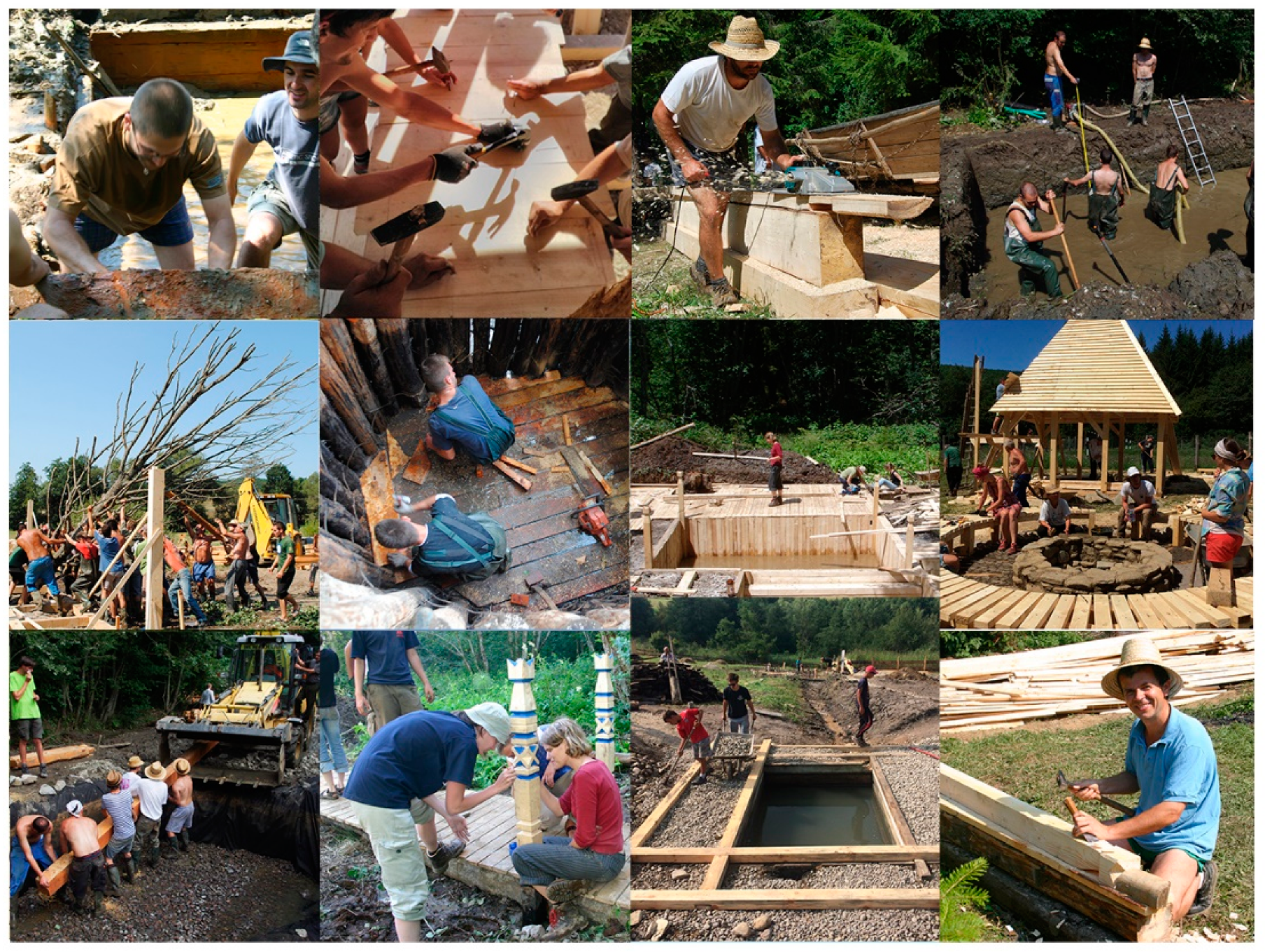

| No | Year of Community Work | Name of Bath | Hungarian and Romanian Name of the Settlement |
|---|---|---|---|
| 1 | 2001 | Nyírfürdő | Lázárfalva/Lazaresti |
| 2 | 2002 | Nádasfürdő | Tusnád/Tusnad |
| 3 | 2003 | Sószékfürdő | Csíkkozmás/Cozmeni |
| 4 | 2004 | Sóskútfürdő | Kászonújfalu/Casinu Nou |
| 5 | 2005 | Borsáros fürdő | Csíkszentkirály/Sancraieni |
| 6 | 2006 | Kerekeger feredő | Csobotfalva/Cioboteni |
| 7 | 2006 | Barátok feredője | Csíksomlyó/Sumuleu-Ciuc |
| 8 | 2006 | Dungó feredő | Homoródkarácsonyfalva/Craciunel |
| 9 | 2006 | Tókerti tanoda | Lázárfalva/Lazaresti |
| 10 | 2007 | Szent Anna feredő | Csíkszenttamás/Tomesti |
| 11 | 2007 | Vallató fürdő | Sepsibükkszád/Bixad |
| 12 | 2008 | Csomafalvi feredő | Gyergyócsomafalva/Ciumani |
| 13 | 2009 | Tündérkerti feredő | Borszék/Borsec |
| 14 | 2010 | Lázárfalvi kút | Lázárfalva/Lazaresti |
| 15 | 2010 | Hammas fürdő | Sepsibükkszád/Bixad |
| 16 | 2011 | Süttei feredő | Sepsibodok/Bodoc |
| 17 | 2012 | Malom és Csókás feredő | Csernáton/Cernat |
| 18 | 2013 | Maczkó bácsi feredője | Kisbacon/Batanu Mic |
| 19 | 2014 | Bugyogó feredő | Zalánpatak/Valea Zalanului |
| 20 | 2015 | Apor lányok feredője | Bálványos/Balvanyos |
| 21 | 2016 | Büdös feredő | Bölön/Belin |
| 22 | 2017 | Nádika fürdő | Gelence/Ghelinta |
| 23 | 2018 | Csipkés feredő | Zabola/Zabala |
| 24 | 2019 | Dungó feredő | Homoródkarácsonyfalva/Craciunel |
Publisher’s Note: MDPI stays neutral with regard to jurisdictional claims in published maps and institutional affiliations. |
© 2022 by the authors. Licensee MDPI, Basel, Switzerland. This article is an open access article distributed under the terms and conditions of the Creative Commons Attribution (CC BY) license (https://creativecommons.org/licenses/by/4.0/).
Share and Cite
Fekete, A.; Herczeg, Á.; Ge, N.D.; Sárospataki, M. Participatory Landscape Design and Water Management—A Sustainable Strategy for Renovation of Vernacular Baths and Landscape Protection in Szeklerland, Romania. Land 2022, 11, 95. https://doi.org/10.3390/land11010095
Fekete A, Herczeg Á, Ge ND, Sárospataki M. Participatory Landscape Design and Water Management—A Sustainable Strategy for Renovation of Vernacular Baths and Landscape Protection in Szeklerland, Romania. Land. 2022; 11(1):95. https://doi.org/10.3390/land11010095
Chicago/Turabian StyleFekete, Albert, Ágnes Herczeg, Ning Dong Ge, and Máté Sárospataki. 2022. "Participatory Landscape Design and Water Management—A Sustainable Strategy for Renovation of Vernacular Baths and Landscape Protection in Szeklerland, Romania" Land 11, no. 1: 95. https://doi.org/10.3390/land11010095
APA StyleFekete, A., Herczeg, Á., Ge, N. D., & Sárospataki, M. (2022). Participatory Landscape Design and Water Management—A Sustainable Strategy for Renovation of Vernacular Baths and Landscape Protection in Szeklerland, Romania. Land, 11(1), 95. https://doi.org/10.3390/land11010095





